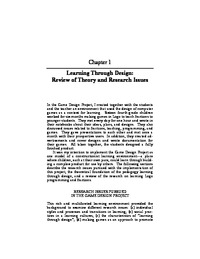Learning Through DesignReview of Theory and Research Issues
|
 |
 Diese Seite wurde seit 4 Jahren inhaltlich nicht mehr aktualisiert.
Unter Umständen ist sie nicht mehr aktuell.
Diese Seite wurde seit 4 Jahren inhaltlich nicht mehr aktualisiert.
Unter Umständen ist sie nicht mehr aktuell.
 Zusammenfassungen
Zusammenfassungen
 In the Game Design Project, I created together with the students
and the teacher an environment that used the design of computer
games as a context for learning. Sixteen fourth-grade children
worked for six months making games in Logo to teach fractions to
younger students. They met every day for one hour and wrote in
their notebooks about their ideas, plans, and designs. They also
discussed issues related to fractions, teaching, programming, and
games. They gave presentations to each other and met once a
month with their prospective users. In addition, they created advertisements
and cover designs and wrote documentation for
their games. All taken together, the students designed a fully
finished product.
In the Game Design Project, I created together with the students
and the teacher an environment that used the design of computer
games as a context for learning. Sixteen fourth-grade children
worked for six months making games in Logo to teach fractions to
younger students. They met every day for one hour and wrote in
their notebooks about their ideas, plans, and designs. They also
discussed issues related to fractions, teaching, programming, and
games. They gave presentations to each other and met once a
month with their prospective users. In addition, they created advertisements
and cover designs and wrote documentation for
their games. All taken together, the students designed a fully
finished product.It was my intention to implement the Game Design Project as one model of a constructionist learning environment—a place where children, each at their own pace, could learn through building a complex product for use by others. The following sections describe the research issues pursued with the implementation of this project, the theoretical foundation of the pedagogy learning through design, and a review of the research on learning Logo programming and fractions.
 Dieses Kapitel erwähnt ...
Dieses Kapitel erwähnt ...
 Dieses Kapitel erwähnt vermutlich nicht ...
Dieses Kapitel erwähnt vermutlich nicht ... 
 Nicht erwähnte Begriffe | Bildung, Eltern, Schule, Unterricht |
 Tagcloud
Tagcloud
 Zitationsgraph
Zitationsgraph
 Zitationsgraph (Beta-Test mit vis.js)
Zitationsgraph (Beta-Test mit vis.js)
 3 Erwähnungen
3 Erwähnungen 
- Vernetztes Lernen mit digitalen Medien - Proceedings der ersten Tagung "Computergestütztes Kooperatives Lernen (D-CSCL 2000)" am 23. und 24. März 2000 in Darmstadt (2000)


- SIGCSE 2013 - The 44th ACM Technical Symposium on Computer Science Education, SIGCSE '13, Denver, CO, USA, March 6-9, 2013 (Tracy Camp, Paul T. Tymann, J. D. Dougherty, Kris Nagel) (2013)
- The social turn in K-12 programming - Moving from computational thinking to computational participation (Yasmin B. Kafai, Leo Leppänen, Quinn Burke, Juho Leinonen, Arto Hellas) (2013)
- Emerging Research, Practice, and Policy on Computational Thinking (Peter J. Rich, Charles B. Hodges) (2017)


- 24. Computational Participation - Teaching Kids to Create and Connect Through Code (Yasmin B. Kafai, Quinn Burke) (2017)


- 24. Computational Participation - Teaching Kids to Create and Connect Through Code (Yasmin B. Kafai, Quinn Burke) (2017)
 Volltext dieses Dokuments
Volltext dieses Dokuments
 Anderswo suchen
Anderswo suchen 
 Beat und dieses Kapitel
Beat und dieses Kapitel
Beat hat Dieses Kapitel während seiner Zeit am Institut für Medien und Schule (IMS) ins Biblionetz aufgenommen. Beat besitzt kein physisches, aber ein digitales Exemplar. (das er aber aus Urheberrechtsgründen nicht einfach weitergeben darf). Aufgrund der wenigen Einträge im Biblionetz scheint er es nicht wirklich gelesen zu haben. Es gibt bisher auch nur wenige Objekte im Biblionetz, die dieses Werk zitieren.









 Computerspiele
Computerspiele Kinder
Kinder LehrerIn
LehrerIn Lernen
Lernen LOGO (Programmiersprache)
LOGO (Programmiersprache) Programmieren
Programmieren , 299 kByte)
, 299 kByte)  Biblionetz-History
Biblionetz-History